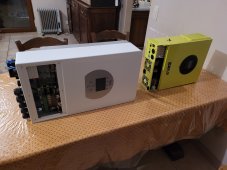mib
New Member
as I understand it, you make changes in the morning and evening uti/sol-sbu
Do you only use a computer now?
Do you only use a computer now?
Since my increase in both solar panels and total battery bank capacity, plus the addition of a 3a battery charger on a timing circuit, I no longer switch between SBU and UTI and simply stay in SBU. I only use the SRNE software on the computer when a change to settings can not be made from the AIO control panel.as I understand it, you make changes in the morning and evening uti/sol-sbu
Do you only use a computer now?
Quite a draw. Not detailed in my review here but in the Up in smoke Forum I found that when I started really loading down the AIO for the first time (boiling spaghetti noodles on my induction burner) that I had insufficient battery cables for the task. I had thought they were 1 awg but in fact they were much smaller, more like 4 awg. They were replaced with 1-0awg.... cook chicken and fries with a continuous draw of 4000W for almost 30 minutes. Everything is fine for now.


Im not able to get the powmr 3k24v to do thisHave not tried this*. I actually see no point to it. The unit consumes power and I simply accept it and incorporate that in my overall strategy.
Voltronic Victron inverters at a much higher entry price point are really not germane when reviewing the EAsun. For one they are not a AIO (unless you talk about their multiplus units which are inverter chargers but lack the SCC and costs almost a $1K more to buy than the EAsun) nor do they offer the same features such as an on unit display and settings access. Victron wants you to buy additional items to use the item you buy. Plus for those in the US they offer much less models that output our voltage needs.
* Tried this 1/20/23 I can confirm that my spare EAsun I-solar 3kw unit charges with the inverter switch in the off position.
Yes, that is the same one. There are many of them out there. They are pretty basic and do not allow stacking for split phase nor can you parallel them. You can see that mentioned in your link in the description area.Is this possibly the same thing also? I want one to match the powmr for split 240
3000W Solar Charge Inverter 24V DC to 110V/120V AC, Off-Grid Soalr Inverter Pure Sine Wave Built-in 60A MPPT Charge Controller Support Parallel for 24V Lead Acid and Lithium Battery https://a.co/d/2qUnfAQ
Is your unit operating in utility bypass?I have the Chins badged unit. Up until now I’ve only connected to pv. I just set up a line to charge off a generator. With pv disconnected the unit says it’s feeding the inverter and charging the batteries but (with no load on inverter) the batteries actually discharge about .8 amps each. Two 12v in series each reporting about 13.2 volts. I figure I’ve munged a setting somewhere but I haven’t found it. I set charging to mains priority but no help. Any thoughts?
Is your unit operating in utility bypass?


